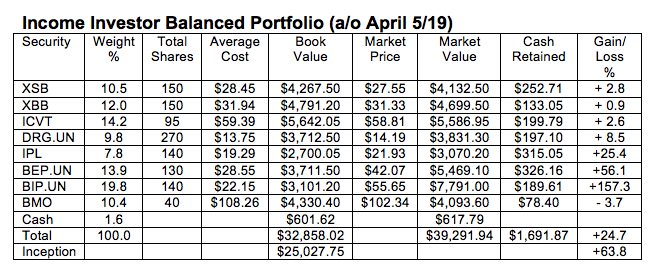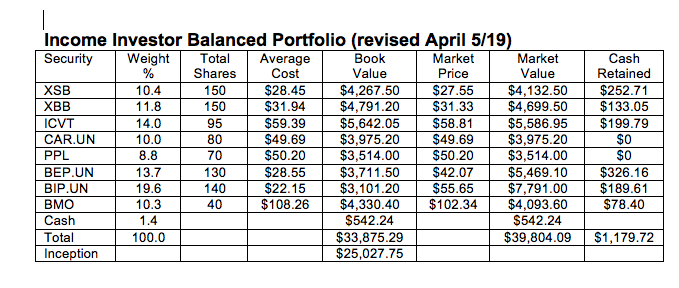A balanced portfolio is all about finding the right blend of stocks and bonds to generate a reasonable return while keeping risk to a minimum.
This model balanced portfolio was launched in September 2011 for my Income Investor newsletter, with an initial valuation of $25,027.75. The goal was to achieve a return that at least matched the best available five-year GIC rate plus two percentage points.
That means the target varies with the rise and fall of interest rates. Right now, the best five-year rate I can find on ratehub.ca is 3.4%, so we are looking for an annual return on this portfolio in excess of 5.4%.
Here’s a summary of how the securities we currently hold performed over the six months since I last reviewed this portfolio at the end of September. Prices are as of the close of trading on April 5.
iShares Canadian Short Term Bond Index ETF (TSX: XSB). Short-term bonds (maturities of five years or less) recovered after the Bank of Canada and the Federal Reserve Board announced that future rate increases are on hold. The unit price was up $0.52 in the past six months, and we received distributions of $0.327 per unit, so we ended up with a net gain of 3.1% for the period.
iShares Canadian Universe Bond ETF (TSX: XBB). The rate freeze by the central banks also helped this fund to a gain of $1.20 during the period. Distributions totalled $0.444 per unit, so we ended with an advance of 5.5%.
iShares Convertible Bond ETF (BATS: ICVT). This ETF invests in a portfolio of convertible bonds, mainly issued by U.S. companies. It was added to the portfolio last September. The price is down $0.58 since then but that was more than made up for by the distributions, which totaled $2.103 per unit.
Dream Global REIT (TSX: DRG.UN). We added this real estate investment trust in March 2018 to diversify the portfolio and try to boost returns. It invests in commercial real estate properties located in Europe. It started off well but then hit a bump in the latest period losing $1.18 per unit. We receive monthly distributions of $0.06667 per unit for a yield of 5.6%.
Inter Pipeline (TSX: IPL, OTC: IPPLF). After a summer rally, shares in Inter Pipeline pulled back, losing $1.21 in the latest period. The monthly dividend was increased to $0.1425, effective with the December payment, so the stock now yields 7.8%. That looks very attractive but the slippage in the share price is a cause for concern.
Brookfield Renewable Energy Limited Partnership (TSX: BEP.UN, NYSE: BEP). This renewable energy limited partnership lost ground in the early part of 2018, hit by rising interest rates. However, it recovered well in the latest period, gaining $3.20 per unit. The distribution was increased by 5.1% in February to US$0.515 per quarter. The units yield 6.6%.
Brookfield Infrastructure Limited Partnership (TSX: BIP.UN, NYSE: BIP). This is another Brookfield partnership, but in this case the assets are invested in infrastructure. After a slump in the first half of last year, the price rebounded strongly, gaining $5.79. The quarterly distribution increased 6.9% in February to US$0.5025. The yield is now 4.8%.
Bank of Montreal (TSX, NYSE: BMO). We added this bank stock in September, just as the banking sector went into a slump. The shares are down $5.92 since then, however we recovered part of that with dividends totaling $1.96 per share.
Cash. We invested $1,405.85 in a high interest savings account with EQ Bank that paid 2.3%. We earned interest of $16.17 for the period.
Here’s how the portfolio stands now. Commissions have not been factored in. For simplicity, Canadian and U.S. dollars are treated as being at par for purposes of the calculations, although obviously, the distributions received from the two Brookfield partnerships and ICVT are worth more in Canadian dollar terms.

Comments: The bond section of this portfolio recovered as the interest rate outlook changed. On the equity side, we saw nice gains from the Brookfield partnerships, but the other three stocks declined. For the six-month period, the net result was a gain of 4.1%.
The cumulative gain since inception is 63.8%. That works out to an annual compound growth rate of 6.8%. That’s better than our target, but I think we can improve on that.
Changes: We’re going to sell our position in Dream Global REIT. The European economy is weak, and this has contributed to the disappointing returns. The sale will give us $4,028.40 to reinvest.
We will use that to buy 80 units of Canadian Apartment Properties REIT (TSX: CAR.UN), a recommendation of our companion Internet Wealth Builder newsletter. The current price is $49.69 for a total cost of $3,975.20.
This REIT has an excellent track record and pays a monthly distribution of $0.115 ($1.38 per year) to yield 2.8%.
We will also sell Inter Pipeline, which has been trending down for some time and replace it with Pembina Pipeline (TSX: PPL, NYSE: PBA), which has a steadier record. We will receive $3,385.25 from the IPL sale.
Pembina shares are trading in Toronto at $50.20. We will buy 70 shares at a cost of $3,514. That will use all the IPL money and we’ll take $128.75 from the remainder of the Dream REIT sale to make up part of the difference.
In all, we received $7,413.65 from the two sales and spent $7,489.20 on the purchases. The balance of $75.55 will come from cash.
The total cash balance of $1,721.96 will be moved to Motive Financial, where it will earn 2.8% in their Money Savvy Savings Account.
Here is the revised portfolio. I will review it again in September.

Gordon Pape is Editor and Publisher of the Internet Wealth Builder and Income Investor newsletters. For more information and details on how to subscribe, go to www.buildingwealth.ca.
Follow Gordon Pape on Twitter at twitter.com/GPUpdates and on Facebook at www.facebook.com/GordonPapeMoney
